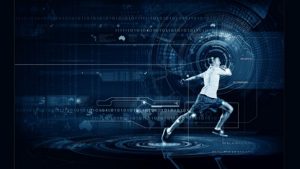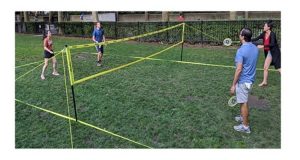
The yoga mats market has witnessed a remarkable rise in recent times due to increasing popularity of yoga across the world. Analysts expect this demand to remain high in the years to come. Just like you need the right pair of running shoes to avoid injuries, its equally important to buy the right mat to suit your workout style.
Best Yoga Mats
Instructional and Educational Yoga Mat

Have recently started doing yoga or plan to start soon? Make sure you get this educational yoga mat that will guide you to do the yoga poses in the right manner.
Its easy to master the various yoga poses with this instructional yoga mat.
The mat features hand and foot placements, printed onto the surface of the mat, that indicates where you need to place your limbs for different poses. The reference points on the mat helps you make the right alignments.
Note: Nothing replaces a good teacher. Listen to your body first, not the mat. Never do anything that causes you pain.
RaveNectar Yoga Mats: Intricate & Vibrant
RaveNectar have used some of the most talented visionary artists to create some truly breathtaking designs on their Yoga mats.

These mats feature amazing colorful patterns that reflect your creativity. So chuck those boring and uninspired designs aside, and turn up for your yoga class with one of these intricate and vibrant yoga mats.
These look beautiful & vibrant, and every time you will roll it out, you’ll fell as if you have bought a new Yoga mat, no wonder many are obsessed with their RaveNectar Yoga Mats.
Yoga Paws Mini Mats
YogaPaws are mini mats that you wear on your hands and feet, allows you to practice anywhere – and leave your mat behind.

Yoga mats are a must for any yoga enthusiast. However, at times its not practical to carry your yoga mat with you.
That is where YogaPaws, mini mats that you wear on your hands and feet, comes across as useful products. These offer the full protection of a normal yoga mat but without the limitations.
They serve as a highly protective rubber mat with uncompromising grip on any type of surface, they feature 5mm of built in padding for maximum wrist and arch support and they also sport an interior towel liner which absorbs 7 times its weight in moisture.
These specially engineered yoga gloves and socks give you enough traction to practice anywhere. The palms and soles grip with cushiony recycled rubber, while mesh on top lets skin breathe. A super absorbent towel lining soaks up water, making YogaPaws stick even when you sweat.
Use it for any type of yoga such as Hot Yoga, Ashtanga, Vinyasa and they can even work in water. Hot yoga lovers use YogaPaws with their mat during class to cut down on slippage.
Lightweight and compact, YogaPaws can be carried in a suitcase, purse, or gym bag.
World’s kindest yoga mat protects your knees
Hailed as the “World’s kindest yoga mat”, Kneebi has been launched on crowdfunding platform Kickstarter.
The mat is the brainchild of designer and Yoga practitioner, Snowcha, who came up with the idea when she experienced discomfort in her knees during even basic yoga poses.

“Most 50-years oldin my class used multiple mats or just put up with the pain. So I decided to create my own solution!” says Snowcha.
Kneebi protects the knees when exercising on hard floors and can be spread out when performing moves or poses that require a much wider surface area. The name Kneebi comes from the Japanese word for double; knee and nibai.
Kneebi can be used in two ways:
- When the wings of the mat are folded in, they provide double padding for the knees, but they are thin enough not to interfere with balance.
- Spread the wings outwards for wide-legged poses, power practice, or stretches.
Key features of Kneebi yoga mat:
- It is easy to roll up, takes up minimal space when not being used, and is as portable and convenient to carry as a traditional yoga mat (weighs approximately 3 to 4 lb).
- It measures 183 cm X 60 cm, or 120 cm when the wings are spread wide open, with a maximum thickness of 5 mm.
- It has high-performance grip on both sides and a textured surface designed to be anti-skid.
- The production process is toxin-free from beginning to end, and Kneebi is eco-friendly, 6P free, 100% latex free, and odor free.
- Kneebi is expected to be available in the following two-tone colors: black and charcoal grey, berry and turquoise, mauve and pink, navy and charcoal grey, dark red and pink, pink and soft blue, and teal and mint.
Yoga Mat: Buying Guide
Why Use a Yoga Mat?
A yoga mat is necessary to help prevent injuries caused by slipping and slippery surfaces. Yoga mats are designed to support users, by preventing their hands and feet from slipping when practicing yoga. They are commonly used at homes and yoga studios.
Whether you occasionally engage in down-dog yoga, or if you are a daily practitioner, it is a good idea to invest in a quality yoga mat, as most of the exercises are done sitting down / lying down on the surface.
A good mat also provides a degree of cushioning between your body and the floor and helps support your feet and hands during certain poses. Good yoga mats will help improve your balance and give you better stability and traction.
A good mat will provide comfort between the floor and your body and cushion your elbows, hips and knees while going through the poses. The mat is also good for creating your own personal space.
Besides being adequately thick, mats need to be durable. They will get a lot of wear and be subject to some significant forces, so they need to be tough as well as gentle on the body.
Factors to Consider
- Buy a mat with the right dimensions, something that suits your body size. You don’t want a mat too think as it could make you unstable and make it difficult to maintain a pose. Too thin a mat is also not good for your knees and elbow joints. Thicker mats also tend to be heavier which can make it inconvenient to carry around. Thin mats are well suited for travelling.
- PVC mats provide the best stickiness, and don’t move around so easily. Texture of the mat also helps get a good grip. Raised, tactile patterns prevent the mat from skidding, and is a big factor when it comes to comfort and protection.
- Opt for closed-cell construction mat, which is slightly slippery in the beginning, but is easier to maintain and the grip also improves over time. These mats do not absorb moisture and as a result they last longer and do not give out bad odour.
- PVC mats are popular and cheaper. Mats with different designs/patterns or the organic ones are priced higher.
Yoga Mat: Construction & Styles
The most important piece of equipment required to practice yoga is the humble yoga mat. Here’s what makes a good yoga mat and the various styles available.
The average yoga mat is around 24 inches across and between 65 and 72 inches long. The standard thickness of ayoga mat is 1/8 of an inch thick.
You get thicker yoga mats as well (double thick mats) that are around 1/4 of an inch thick and tend to be preferred by older yoga practitioners, or those with knee and hip issues.
Most yoga mats are constructed out of a plastic called polyvinyl chloride or PVC. This yoga mat material helps to keep slipping to a minimum and also is the most affordable. The downside to a PVC mat is that it is a toxic plastic that is costly and difficult to recycle.
Also, PVC is something you would not want your skin to be in close contact with. Because of this, many yoga mats are now made of more natural products, and there is quite a wide range to choose from. If you are environmentally minded, take the green route and pick a yoga mat that’s made out of jute, bamboo, cotton, or recycled rubber.
A quality yoga mat is an essential for the yoga practitioner. Using a rug, or gym cushion can be inconvenient; gymnastic rugs and cushions or soft pilates mats are too thick and can make balancing difficult. And in this day and age a certain level of environmental responsibility is also important.
Hemp Yoga Mats
Mats made from 100% hemp are an excellent product with outstanding environmental credentials. Certified organic hemp is totally free from chemicals and has a strength that totally belies its softness and comfort.
Cotton Yoga Mats
Cotton yoga mats tend to be the softest in the range, but also the heaviest. Most people chose to have a cotton yoga mat for home practice simply because they tend to be a bit difficult to carry around. Cotton is less likely to cause any kind of allergic reaction if you are that way inclined, and organically grown cotton is an even better choice of yoga mat.
Bamboo Yoga Mats
Incredibly, bamboo can be used to create an enormous number of products and bamboo yoga mats are of a very high standard. Bamboo mats are very light and soft and come in a range of thicknesses – even the thickest mat remains quite lightweight. Bamboo is a sustainable crop, so you may feel confident a bamboo mat has had minimal impact on the planet.
Demand for yoga mats rise due to rising popularity of yoga across the world
According to a research report, North America, Europe, Southeast Asia, China, Japan, and India are the primary regional markets for yoga mats. India, being the origin of Yoga, leads the demand for yoga mats across the world.
Yoga mats are classified into rubber yoga mats, PVC yoga mats, and TPE yoga mats. PVC yoga mats report a higher demand among consumers than other yoga mats due to the grip they provide.
Currently, the demand for yoga mats for household purposes is more than the demand for yoga mats for yoga clubs.
Leading manufacturers of yoga mats across the world include Manduka PROlite, Easyoga, HATHAYOGA, Gaiam, Yogarugs, JiangXi Lveten Plastic, Khataland, Kharma Khare, Aerolite, Aurorae, Barefoot Yoga, Hosa Group, PrAna Revolutionary, Copeactive, Lululemon, Yogabum, Jade Yoga, A. Kolckmann, Hugger Mugger Para Rubber, Yogasana, Liforme, Keep well, and Microcell Composite.
Browse Complete “Global Yoga Mat Market Research Report 2016”. This research study provides an all-inclusive analysis of the worldwide yoga mat market, taking various factors, such as production capacity, pricing of the product, the dynamics of demand and supply, revenue, and the growth rate of the overall market, in consideration.
Ways to Recycle Your Old Yoga Mat
Bought a new Yoga Mat? Here’s how to recycle your old yoga mat.
You’ve just bought a brand-new, environmentally friendly eco-yoga mat, and you’re feeling great. You’re at one with the planet and your practice is now as green as can be. But what to do with your old yoga mat? You could hide it in the back of your closet, or you could give it new purpose by re-using or recycling it.
Yoga mat recycling programs are springing up all over the place as many yogis express a desire to make their practice as earth friendly as possible. Yoga is a philosophy that gives so much to its devotees and many now feel a need to give something back themselves. Helping ‘green’ the yoga industry is an important factor for many yogis, and recycling your old yoga mat is one way to start doing that.
Here are some tips and tricks for re-purposing / reusing your old yoga mat.
- Your old yoga mat’s non-slip properties make it very useful in your car. If you line the trunk of your car with your old yoga mat it will help keep groceries and other items from sliding around back there. It’s also great laid across the back seat of your car to protect the upholstery from sports gear or muddy dog feet etc. Having your old mat in your car also makes those spur of the moment picnics that little bit more comfortable!
- Turn your old mat into a new yoga prop. Put it under your new mat for some extra cushioning for those floor poses, or roll it up inside an old piece of material to make a bolster for supported reclining poses.
- Cut it into small squares to place under pot plants around the house. The mat will protect your floor or furniture from scratches and water leaks.
- Recycle Your Mat is a program that collects mats from all around the country. RecycleYourMat.com sorts old mats and sends them on to be made into padding for laptop bags and other products. Many studios will have a collection service as the company partners with Manduka – you may get a discount for adding your mat to the recycling program.
- The Bolder Mat Company is an organisation that accepts donations of mats that are still in reasonably good condition. At the company they are cleaned, and then sent on at no charge to prisons, shelters and schools who have requested yoga mats. Your old mat is then gratefully used by a less fortunate member of our community, who will then be able to experience the benefits of yoga and enrich their life.
Watch: How to make Flip Flops from a Yoga Mat
- Donate it: To a homeless shelter where it can be used as a sleeping mat, to an animal rescue shelter where they always need extra matting for crates etc., to day care centres where they can use it for arts and crafts or to create games and activities, to a nursing home (or elderly person) where it will make a great non-slip bath mat, or even to somebody who doesn’t have their own yoga mat yet.
- Store it in your car: To line the back seat or boot when you’re transporting messy things like plants, or when you’re taking the dog out (particularly if they’re likely to get back into the car wet), to stop groceries slipping, or to use as a make-shift ground covering to sit on or instead of a beach towel or picnic blanket.
- Use it to stop slipping: On the floor in work areas where it’s very slippery, under a rug to stop it from slipping, or on shelves or workbenches (such as in the kitchen, or in the garage).
- Cut it up to create: Squares, circles or anything else to use during kids’ games and activities (masks are a fun one!), kneeling pads to use when gardening, drawer liners, a mouse pad, a grip pad for opening jars, liners under house plant pots, coasters, or pads for the bottom of furniture to protect wood or tiled floors.
- Be practical by: Using it as a sleeping mat when you go camping, to wrap valuables when packing or moving, plugging up drafty gaps in windows and doors with it, or placing a mat in front of the kitty litter or under the pet food dishes.
External Links
- Clutch bag, flip-flops, iPad case. 20 creative uses for a yoga mat
- HOW to make studded Napkin Rings (recycle your yoga mat!)
- HOW to make a Jar Opener from an old yoga mat
Yoga mats take GST hit in India
Despite Yoga era, Yoga mats gets classified as luxury good in India, to be taxed more as its classified as luxury good.
“If you take a look at the items taxed in the highest bracket of 28%, you will be surprised to see yoga mats, they have been classified as as luxury goods. PM Modi, who is promoting yoga to the world, has left fitness enthusiasts and yoga exponents wondering with the steep hike in price of yoga equipment.
Indian PM Modi may have heralded a new yoga era, but the yoga mat has taken a GST hit. Classified as a luxury good, the mat will be taxed at 28%. Sporty goods such as skipping ropes, shoes and ankle weights have also been classified as luxury goods.
PM Modi believes yoga can play a big role in bridging India with the world.
Traders Association of Sporting Goods and Physical Exercise Equipment (TASGPEE) is not happy with the higher tax and has requested the GST Council to reconsider taxes on fitness equipment.
Equipment for physical exercise and fitness are an integral part of any sportsperson fitness regime. For example athletic equipment includes javelin, high jump mat, hurdles, relay baton, spiked shoes. Gymnastics equipment includes parallel bar, parallel beam, Roman rings, competition high bar, climbing rope, etc. General physical equipment includes yoga mat, yoga bricks, skipping ropes, dumbbells, weight lifting equipment, gym ball, treadmills, home gym, exercise bike.
The association said that 28% bracket was for luxury products, but in a country like India that is grappling with lifestyle diseases, fitness equipment should not be considered luxury products.
We serious hope that authorities reconsider their decision and revise the taxes downwards.









Leave a Reply